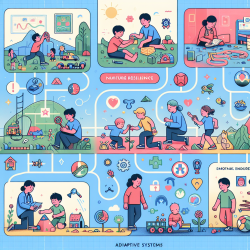Introduction
In the realm of adolescent mental health, the accurate assessment of conditions such as depression and anxiety is crucial for effective intervention and resource allocation. A recent study titled "Translation, cultural adaptation and validation of Patient Health Questionnaire and generalized anxiety disorder among adolescents in Nepal" provides valuable insights into this process. This blog aims to guide practitioners in implementing the findings from this research to enhance their skills and improve outcomes for adolescents.
The Importance of Cultural Adaptation
Adolescents in diverse cultural settings, like Nepal, face unique challenges that can impact their mental health. The study conducted in Kathmandu highlights the need for culturally adapted tools to accurately measure depression and anxiety. By adapting the Patient Health Questionnaire for Adolescents (PHQ-A) and the Generalized Anxiety Disorder (GAD-7) scale, researchers were able to ensure these tools were relevant and understandable for Nepali adolescents.
Key Findings and Their Implications
The study revealed that the PHQ-A and GAD-7, when culturally adapted, demonstrated fair psychometric properties for screening depression, although they performed less optimally for anxiety. The research highlighted the importance of using context-specific language and examples to make the tools relatable to adolescents. For instance, the study found that activities like watching TV or playing mobile games were more relevant to today's adolescents compared to previous generations.
Furthermore, the research suggested different cut-off scores for younger and older adolescents, as well as for boys and girls, to improve accuracy. For example, a PHQ-A cut-off of >13 for younger adolescents showed a sensitivity of 0.93 and specificity of 0.80. These findings underscore the importance of tailoring assessment tools to specific demographic groups to enhance their effectiveness.
Practical Application for Practitioners
Practitioners can leverage these findings to refine their assessment practices. Here are some actionable steps:
- Adopt Culturally Adapted Tools: Use culturally adapted versions of the PHQ-A and GAD-7 to ensure accurate assessments. This approach respects cultural nuances and improves communication with adolescents.
- Customize Cut-off Scores: Implement different cut-off scores based on age and gender to enhance diagnostic accuracy. This customization can lead to more precise identification of mental health issues.
- Incorporate Contextual Examples: Use examples and language that resonate with the adolescent's cultural context. This helps in building rapport and encourages honest communication.
Encouraging Further Research
The study also opens avenues for further research. Practitioners are encouraged to explore how these adapted tools perform in different cultural settings and to contribute to the development of more inclusive mental health assessment tools. Collaborative efforts between researchers and practitioners can lead to innovations that better serve diverse adolescent populations.
Conclusion
The cultural adaptation and validation of mental health assessment tools, as demonstrated in this study, are essential for improving adolescent mental health outcomes. By implementing these insights, practitioners can make data-driven decisions that are culturally sensitive and effective. For those interested in delving deeper into the research, the original paper offers a comprehensive exploration of the methodologies and findings.
To read the original research paper, please follow this link: Translation, cultural adaptation and validation of Patient Health Questionnaire and generalized anxiety disorder among adolescents in Nepal.










